Abstract
The possibility that Graves' ophthalmopathy and autoimmune thyroid disorders may be associated because of autoimmune reactions against antigens shared between human orbital and thyroid tissues was investigated using anti-thyroglobulin (Tg) monoclonal and autoantibodies. Eleven of 16 mouse monoclonal antibodies (MCAB) tested reacted, in an enzyme-linked immunosorbent assay (ELISA), with an antigen in human orbital connective tissue membranes (OCTmem), but not with the OCT soluble fraction, or with membrane or soluble fractions of human eye muscle, lacrimal gland or skin connective tissue. The anti-OCTmem activity was absorbed by OCTmem and Tg, but not by liver membranes or bovine serum albumin (BSA). In preliminary studies four out of 113 human MCAB against thyroid or orbital tissue antigens showed reactivity restricted to Tg and OCTmem. Sera from approximately 50% of patients with autoimmune thyroid disorders, with or without ophthalmopathy, also reacted with OCTmem. The autoantibody activity correlated closely with serum titres of antithyroglobulin but not with the presence, duration, or severity of the eye disease. The OCTmem reactivity was absorbed by Tg, thyroid membranes, and OCTmem but not liver membranes, membranes prepared from other orbital tissues, or BSA. The OCTmem-Tg shared antigen site appeared not to be native thyroglobulin since, (i) MCAB and serum autoantibodies did not react with the cytosol fraction of OCT, and (ii) because the membrane antigen was not solubilizable. Because not all patients with ophthalmopathy have detectable anti-Tg antibodies and, conversely, because not all patients with detectable anti-Tg antibodies develop ophthalmopathy it is unlikely that autoimmunity against a OCTmem-Tg shared antigen is the primary mechanism of Graves' ophthalmopathy, although this possibility has not been excluded. On the other hand the reaction of anti-Tg autoantibodies with OCT membranes may be a model for other autoimmune reactions against other thyroid-orbital tissue-shared antigens. While the pathogenesis of Graves' ophthalmopathy is likely to be multifactorial, humoral and cellular reactions against primary orbital antigens, thyroid-orbitol tissue shared antigens, or both, are likely to play important roles.
Full text
PDF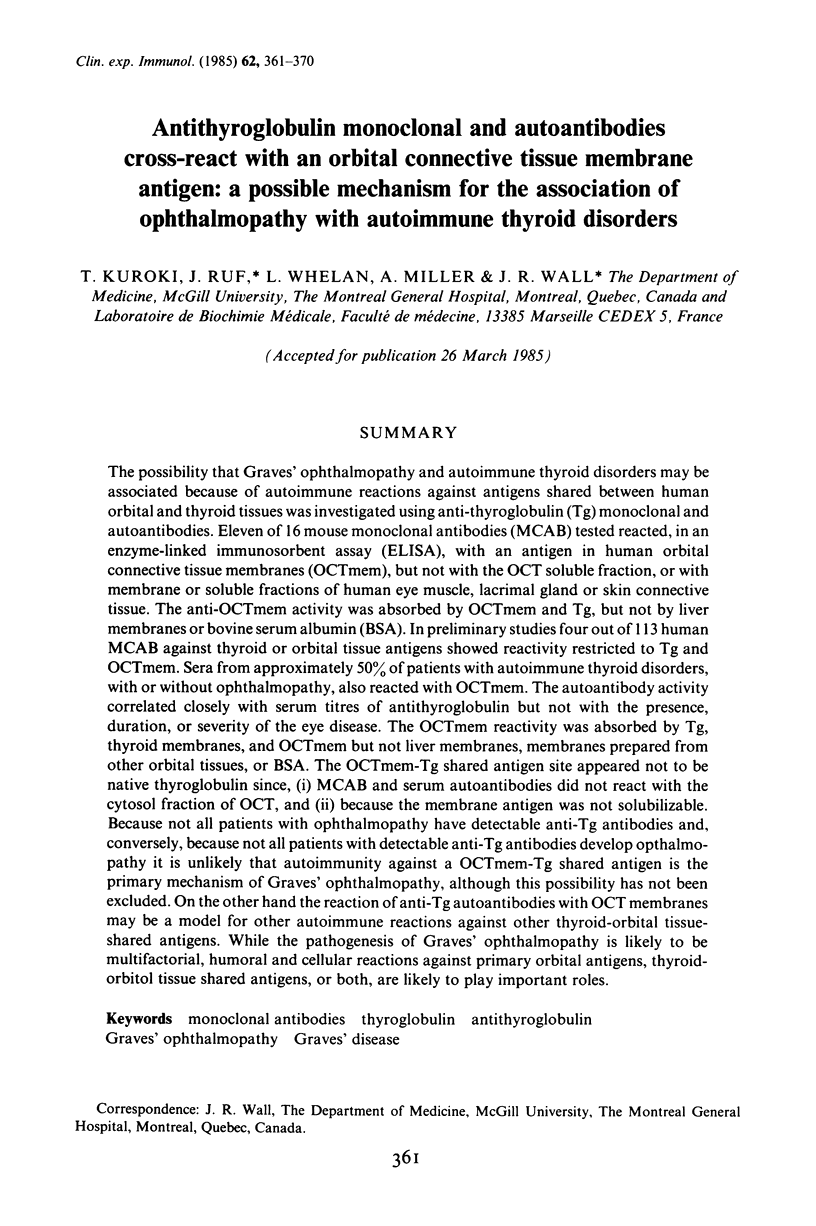
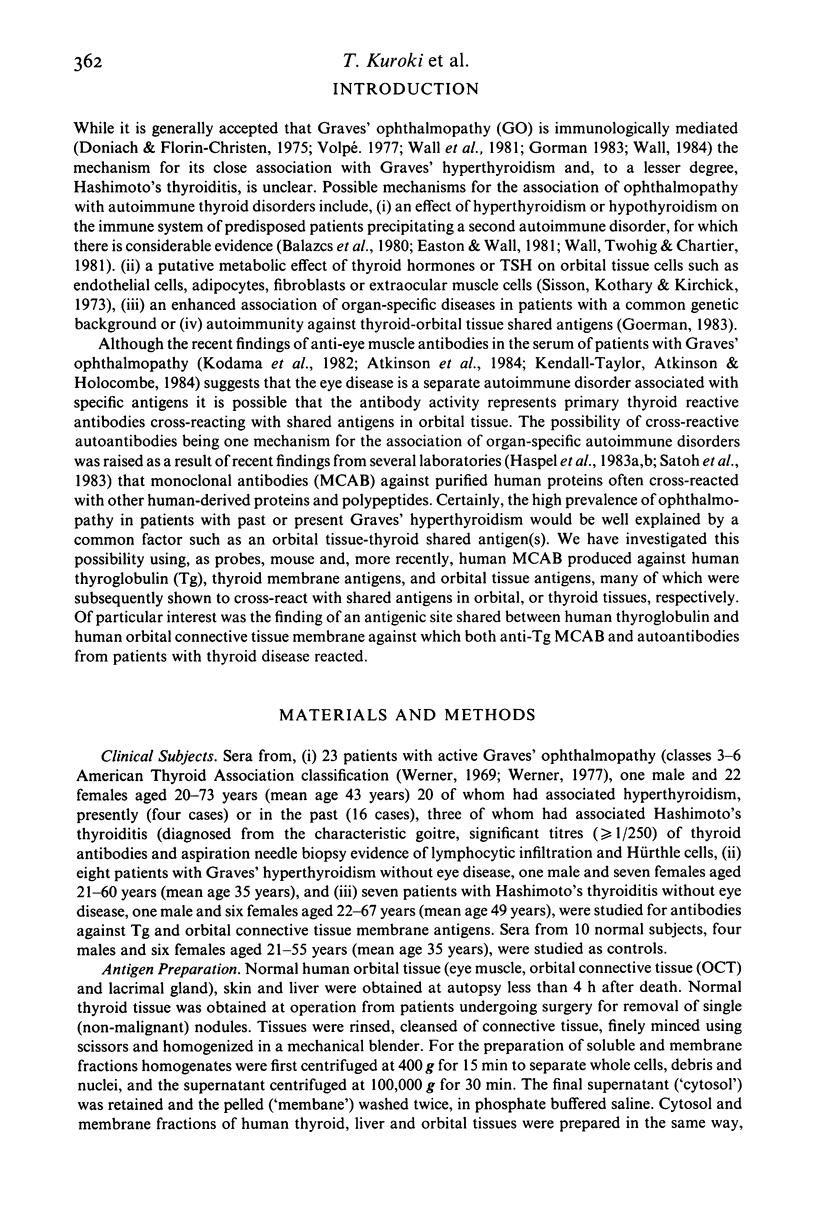
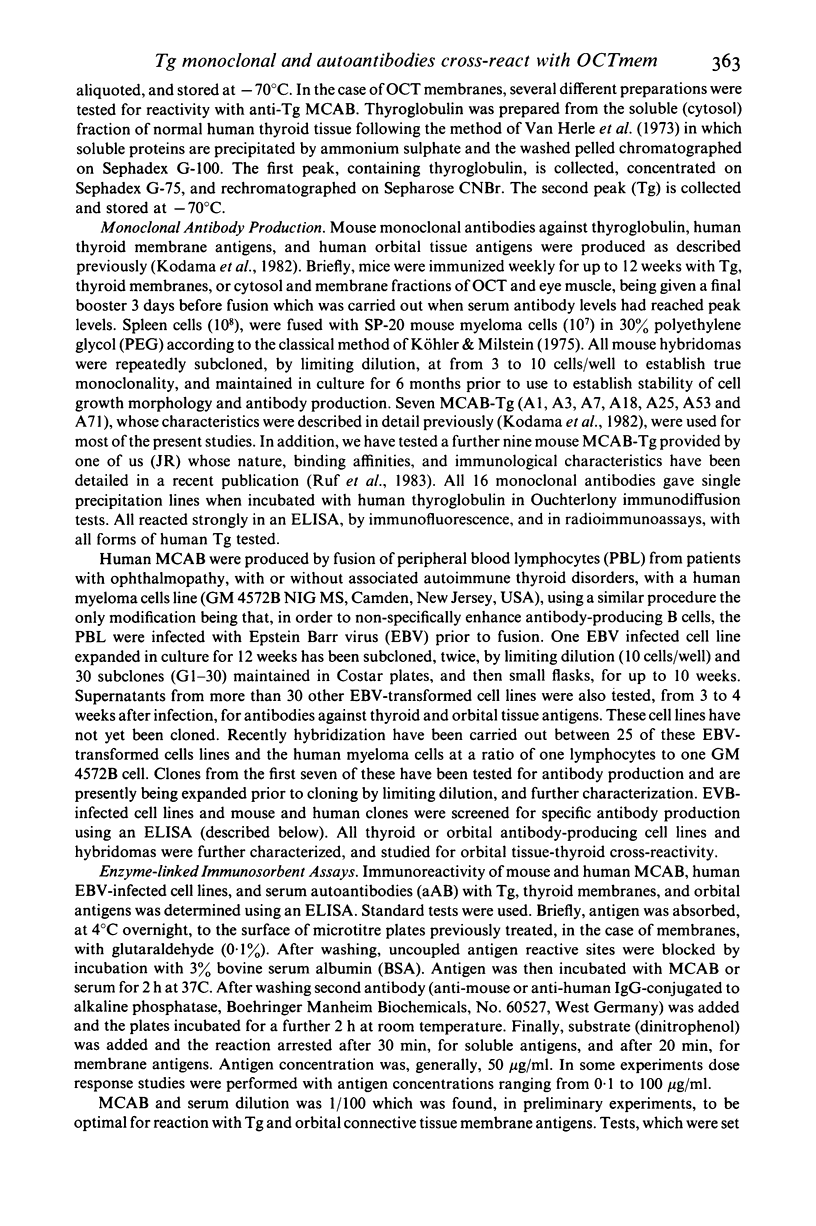
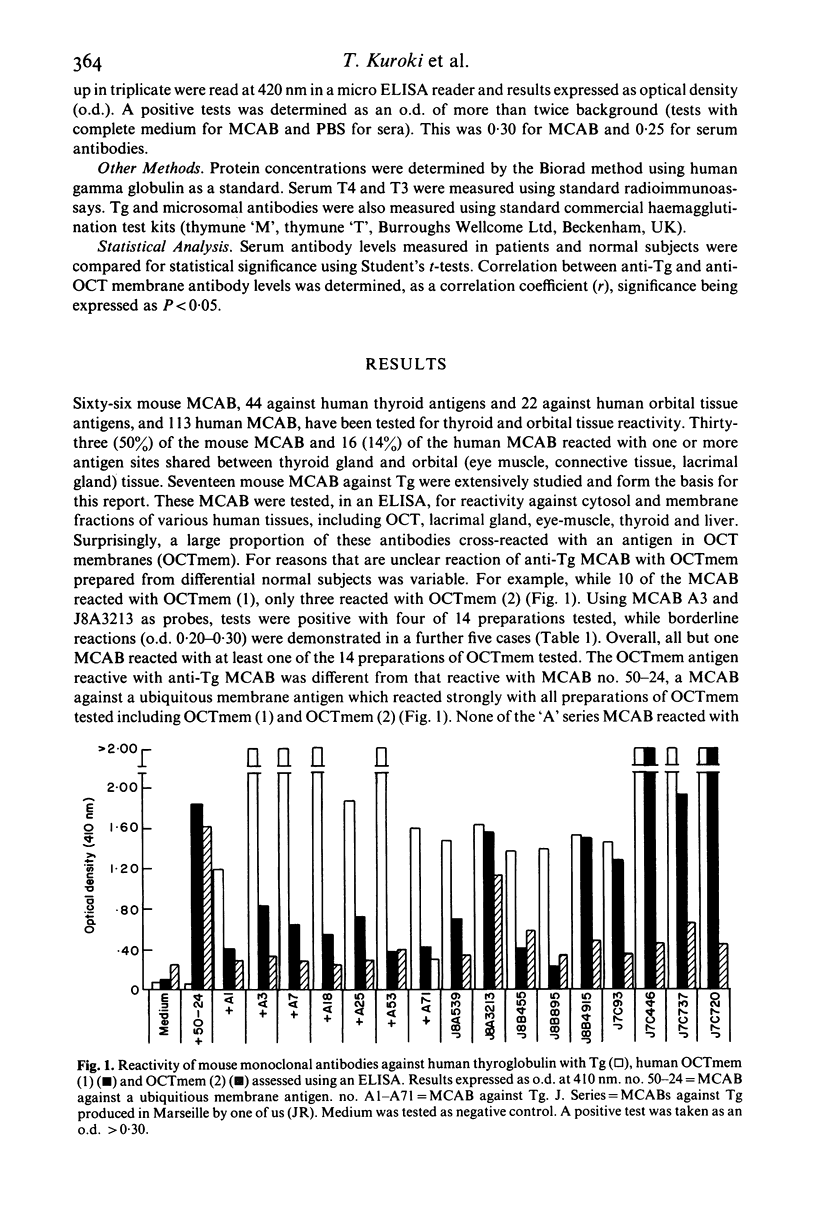
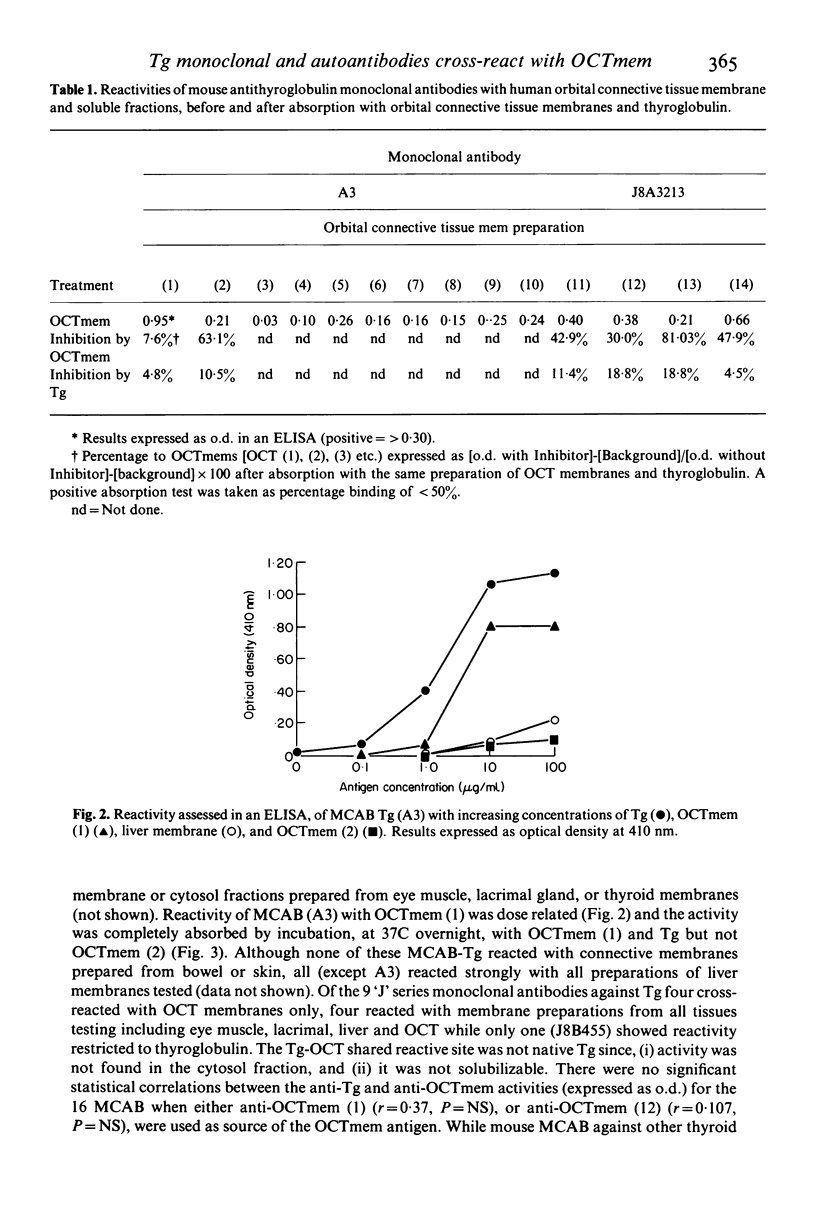
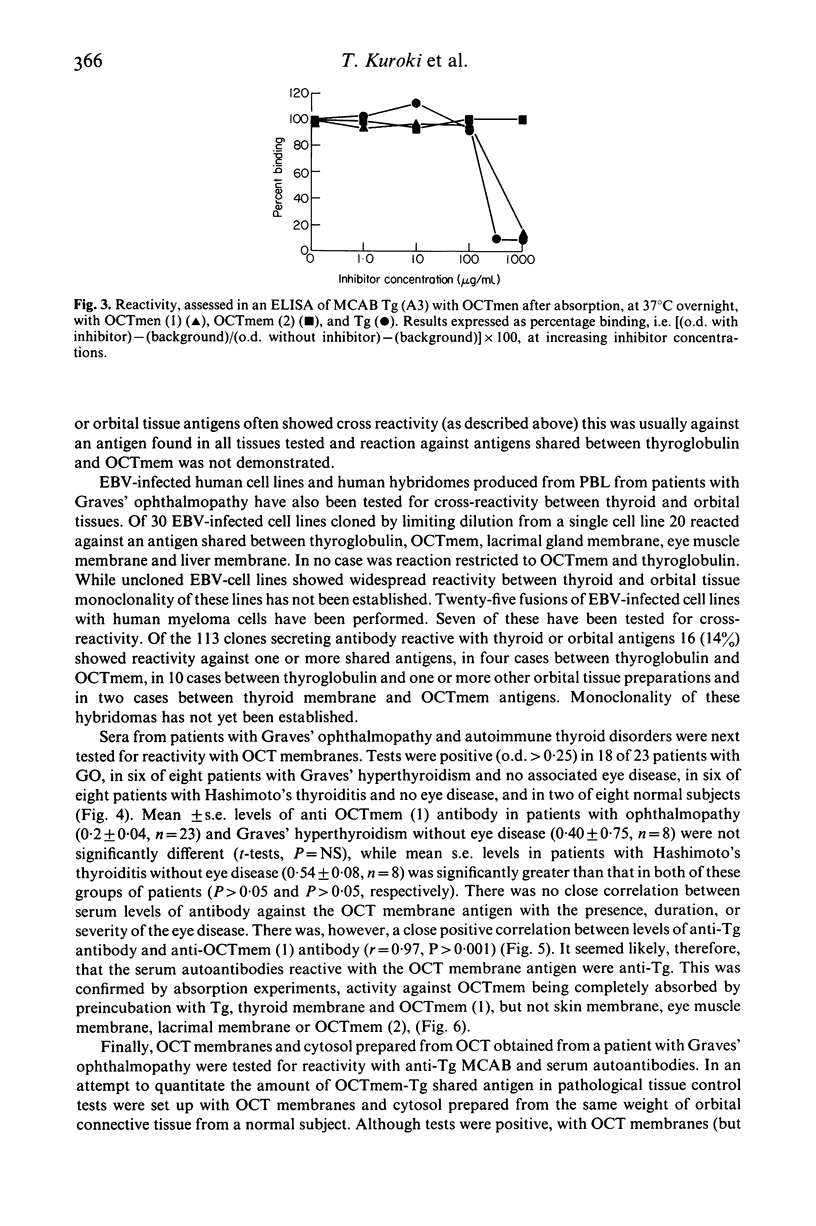
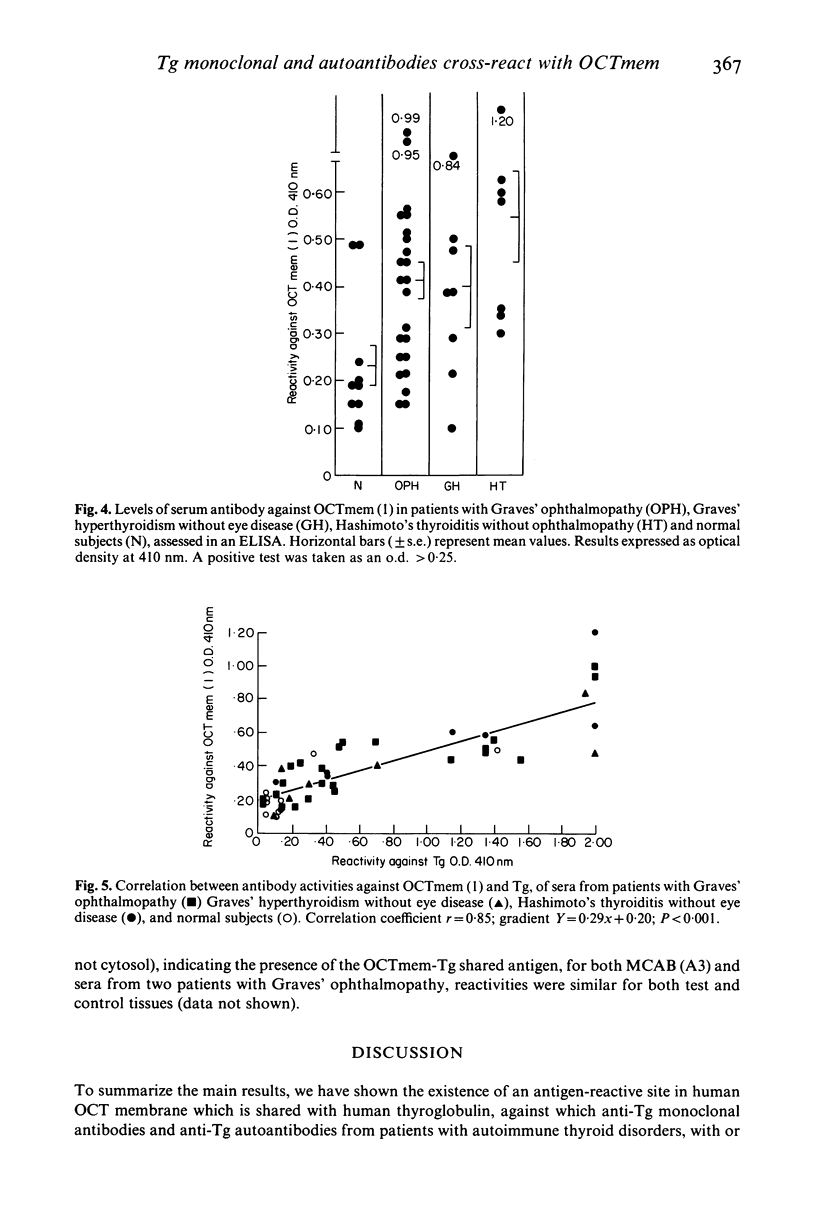
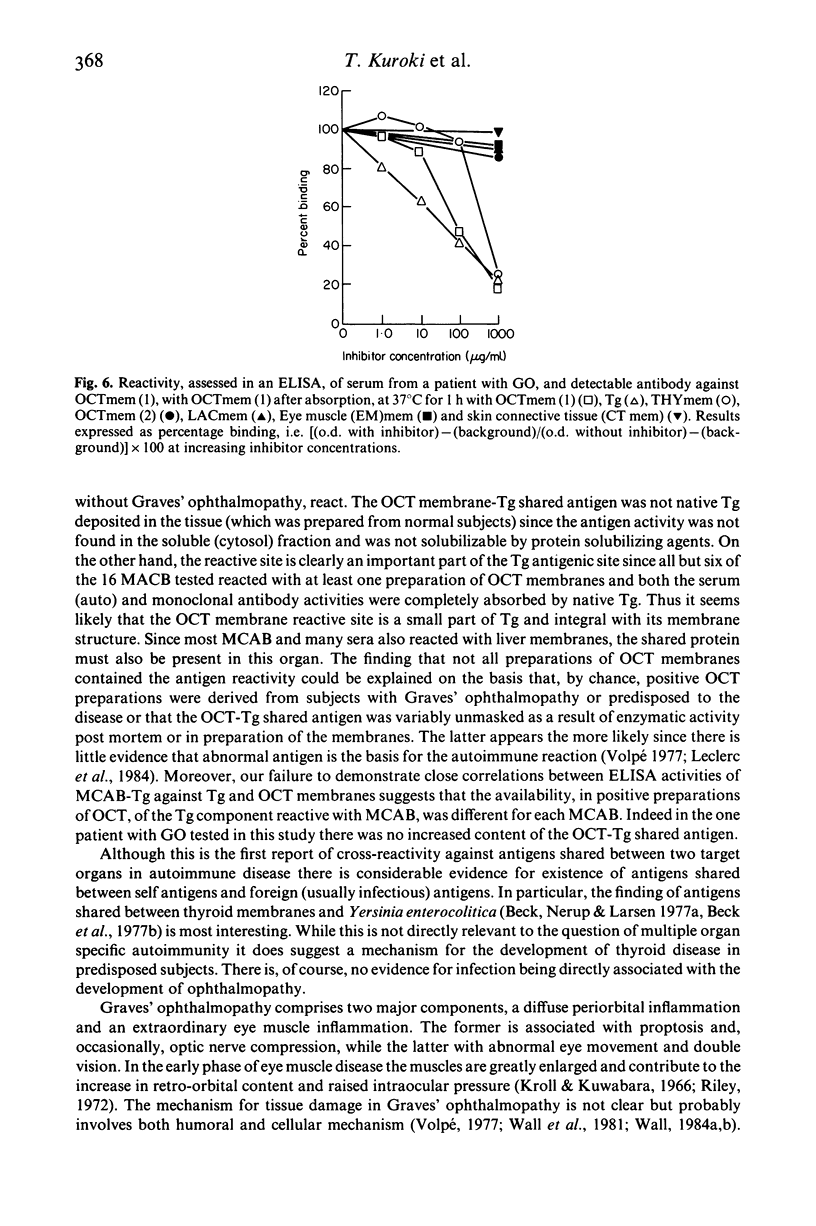
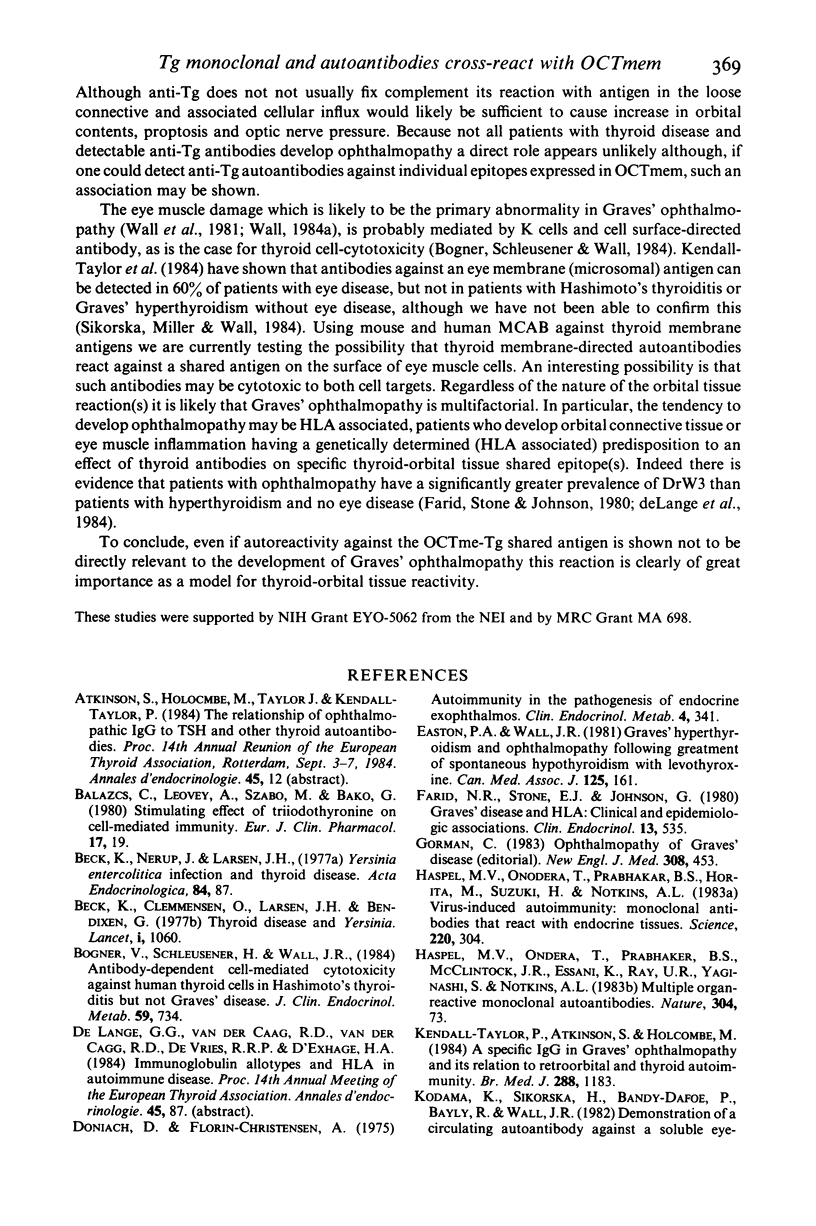
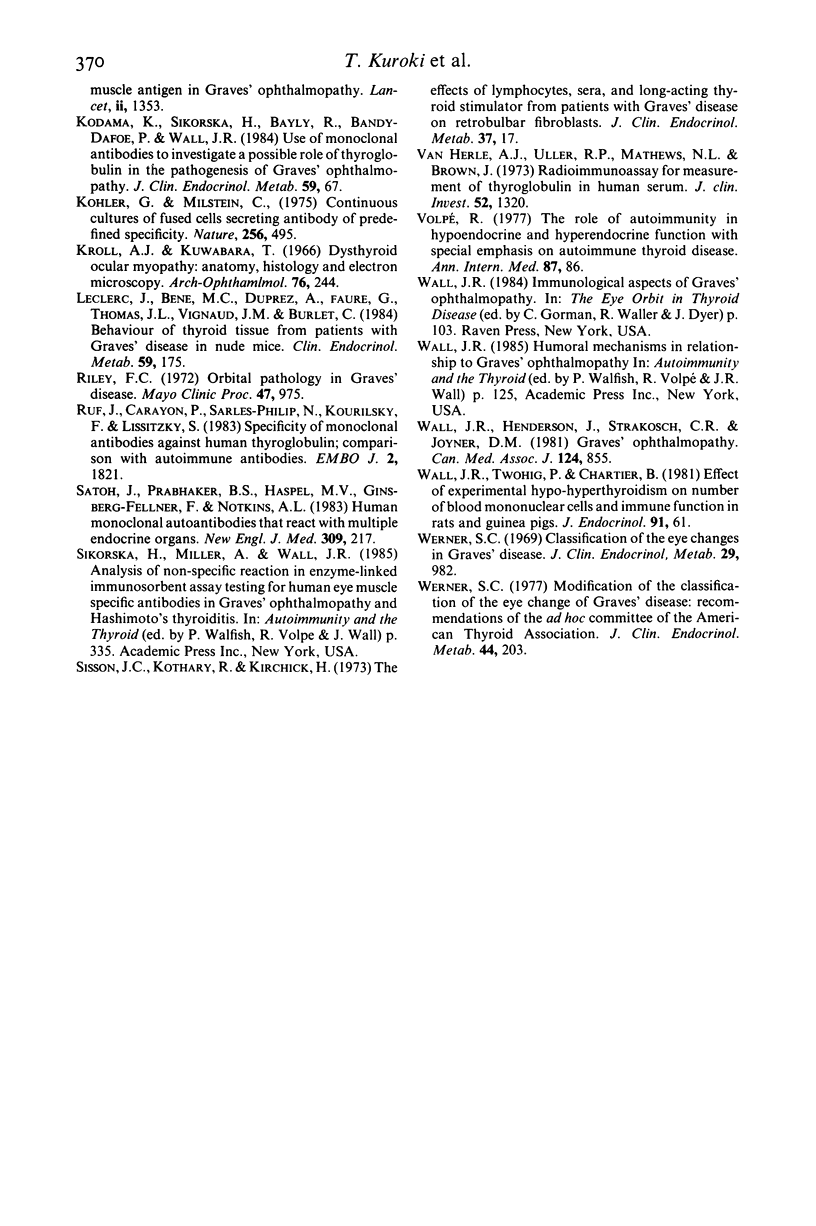
Selected References
These references are in PubMed. This may not be the complete list of references from this article.
- Balázs C., Leövey A., Szabó M., Bakó G. Stimulating effect of triiodothyronine on cell-mediated immunity. Eur J Clin Pharmacol. 1980 Jan;17(1):19–23. doi: 10.1007/BF00561672. [DOI] [PubMed] [Google Scholar]
- Bogner U., Schleusener H., Wall J. R. Antibody-dependent cell mediated cytotoxicity against human thyroid cells in Hashimoto's thyroiditis but not Graves' disease. J Clin Endocrinol Metab. 1984 Oct;59(4):734–738. doi: 10.1210/jcem-59-4-734. [DOI] [PubMed] [Google Scholar]
- Farid N. R., Stone E., Johnson G. Graves' disease and HLA: clinical and epidemiologic associations. Clin Endocrinol (Oxf) 1980 Dec;13(6):535–544. doi: 10.1111/j.1365-2265.1980.tb03421.x. [DOI] [PubMed] [Google Scholar]
- Gorman C. Ophthalmopathy of Graves' disease. N Engl J Med. 1983 Feb 24;308(8):453–454. doi: 10.1056/NEJM198302243080811. [DOI] [PubMed] [Google Scholar]
- Haspel M. V., Onodera T., Prabhakar B. S., Horita M., Suzuki H., Notkins A. L. Virus-induced autoimmunity: monoclonal antibodies that react with endocrine tissues. Science. 1983 Apr 15;220(4594):304–306. doi: 10.1126/science.6301002. [DOI] [PubMed] [Google Scholar]
- Haspel M. V., Onodera T., Prabhakar B. S., McClintock P. R., Essani K., Ray U. R., Yagihashi S., Notkins A. L. Multiple organ-reactive monoclonal autoantibodies. Nature. 1983 Jul 7;304(5921):73–76. doi: 10.1038/304073a0. [DOI] [PubMed] [Google Scholar]
- Kendall-Taylor P., Atkinson S., Holcombe M. A specific IgG in Graves' ophthalmopathy and its relation to retro-orbital and thyroid autoimmunity. Br Med J (Clin Res Ed) 1984 Apr 21;288(6425):1183–1186. doi: 10.1136/bmj.288.6425.1183. [DOI] [PMC free article] [PubMed] [Google Scholar]
- Kodama K., Sikorska H., Bandy-Dafoe P., Bayly R., Wall J. R. Demonstration of a circulating autoantibody against a soluble eye-muscle antigen in Graves' ophthalmopathy. Lancet. 1982 Dec 18;2(8312):1353–1356. doi: 10.1016/s0140-6736(82)91267-3. [DOI] [PubMed] [Google Scholar]
- Kodama K., Sikorska H., Bayly R., Bandy-Dafoe P., Wall J. R. Use of monoclonal antibodies to investigate a possible role of thyroglobulin in the pathogenesis of Graves' ophthalmopathy. J Clin Endocrinol Metab. 1984 Jul;59(1):67–73. doi: 10.1210/jcem-59-1-67. [DOI] [PubMed] [Google Scholar]
- Kroll A. J., Kuwabara T. Dysthyroid ocular myopathy. Anatomy, histology, and electron microscopy. Arch Ophthalmol. 1966 Aug;76(2):244–247. doi: 10.1001/archopht.1966.03850010246017. [DOI] [PubMed] [Google Scholar]
- Köhler G., Milstein C. Continuous cultures of fused cells secreting antibody of predefined specificity. Nature. 1975 Aug 7;256(5517):495–497. doi: 10.1038/256495a0. [DOI] [PubMed] [Google Scholar]
- Leclere J., Bene M. C., Duprez A., Faure G., Thomas J. L., Vignaud J. M., Burlet C. Behaviour of thyroid tissue from patients with Graves' disease in nude mice. J Clin Endocrinol Metab. 1984 Jul;59(1):175–177. doi: 10.1210/jcem-59-1-175. [DOI] [PubMed] [Google Scholar]
- Ruf J., Carayon P., Sarles-Philip N., Kourilsky F., Lissitzky S. Specificity of monoclonal antibodies against human thyroglobulin; comparison with autoimmune antibodies. EMBO J. 1983;2(10):1821–1826. doi: 10.1002/j.1460-2075.1983.tb01664.x. [DOI] [PMC free article] [PubMed] [Google Scholar]
- Satoh J., Prabhakar B. S., Haspel M. V., Ginsberg-Fellner F., Notkins A. L. Human monoclonal autoantibodies that react with multiple endocrine organs. N Engl J Med. 1983 Jul 28;309(4):217–220. doi: 10.1056/NEJM198307283090405. [DOI] [PubMed] [Google Scholar]
- Sisson J. C., Kothary P., Kirchick H. The effects of lymphocytes, sera, and long-acting thyroid stimulator from patients with Graves' disease on retrobulbar fibroblasts. J Clin Endocrinol Metab. 1973 Jul;37(1):17–24. doi: 10.1210/jcem-37-1-17. [DOI] [PubMed] [Google Scholar]
- Van Herle A. J., Uller R. P., Matthews N. I., Brown J. Radioimmunoassay for measurement of thyroglobulin in human serum. J Clin Invest. 1973 Jun;52(6):1320–1327. doi: 10.1172/JCI107303. [DOI] [PMC free article] [PubMed] [Google Scholar]
- Volpé R. The role of autoimmunity in hypoendocrine and hyperendocrine function: with special emphasis on autoimmune thyroid disease. Ann Intern Med. 1977 Jul;87(1):86–99. doi: 10.7326/0003-4819-87-1-86. [DOI] [PubMed] [Google Scholar]
- Wall J. R., Henderson J., Strakosch C. R., Joyner D. M. Graves' ophthalmopathy. Can Med Assoc J. 1981 Apr 1;124(7):855-62, 866. [PMC free article] [PubMed] [Google Scholar]
- Wall J. R., Twohig P., Chartier B. Effects of experimental hyper- and hypothyroidism on numbers of blood mononuclear cells and immune function in rats and guinea-pigs. J Endocrinol. 1981 Oct;91(1):61–67. doi: 10.1677/joe.0.0910061. [DOI] [PubMed] [Google Scholar]
- Werner S. C. Modification of the classification of the eye changes of Graves' disease: recommendations of the Ad Hoc Committee of the American Thyroid Association. J Clin Endocrinol Metab. 1977 Jan;44(1):203–204. doi: 10.1210/jcem-44-1-203. [DOI] [PubMed] [Google Scholar]


